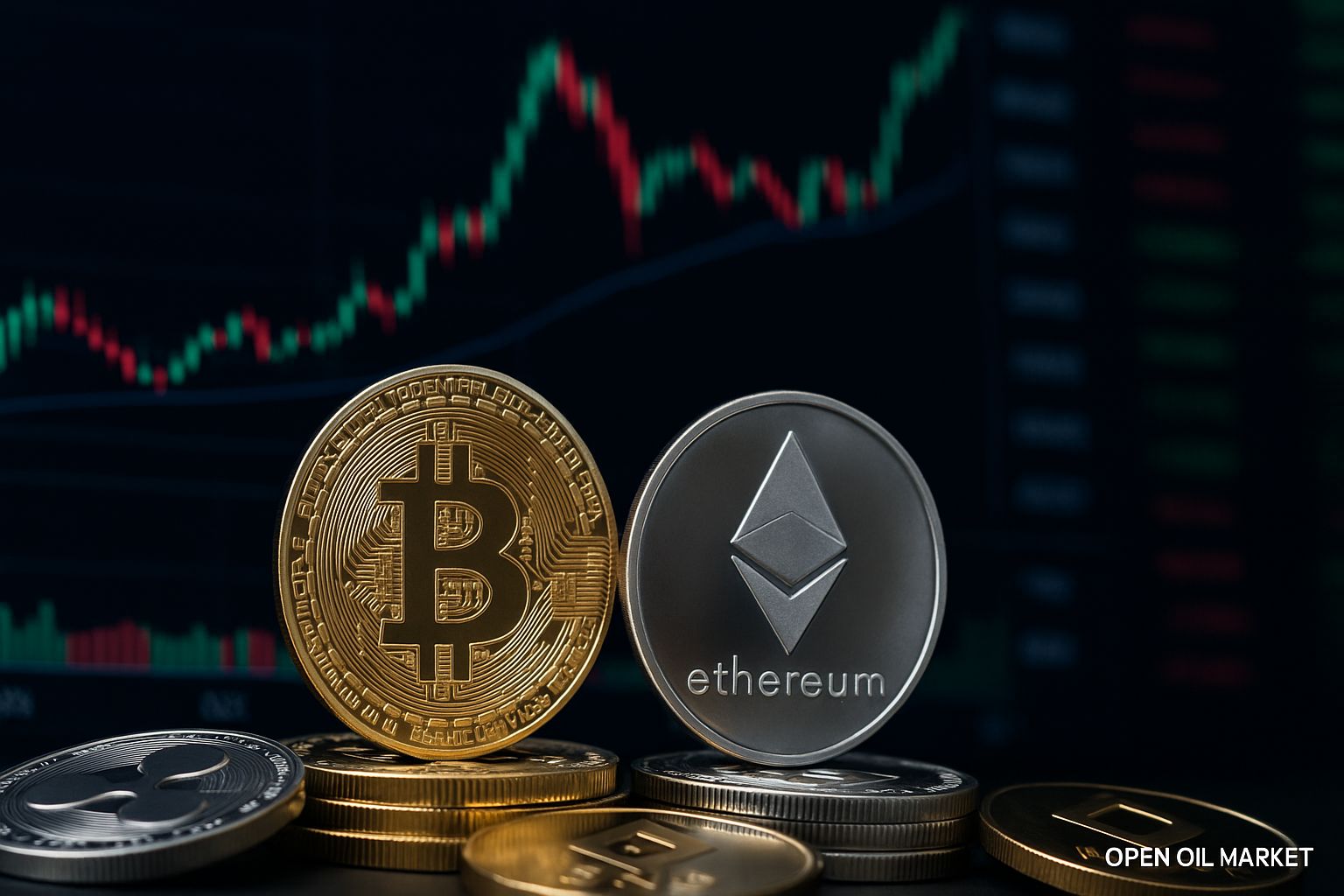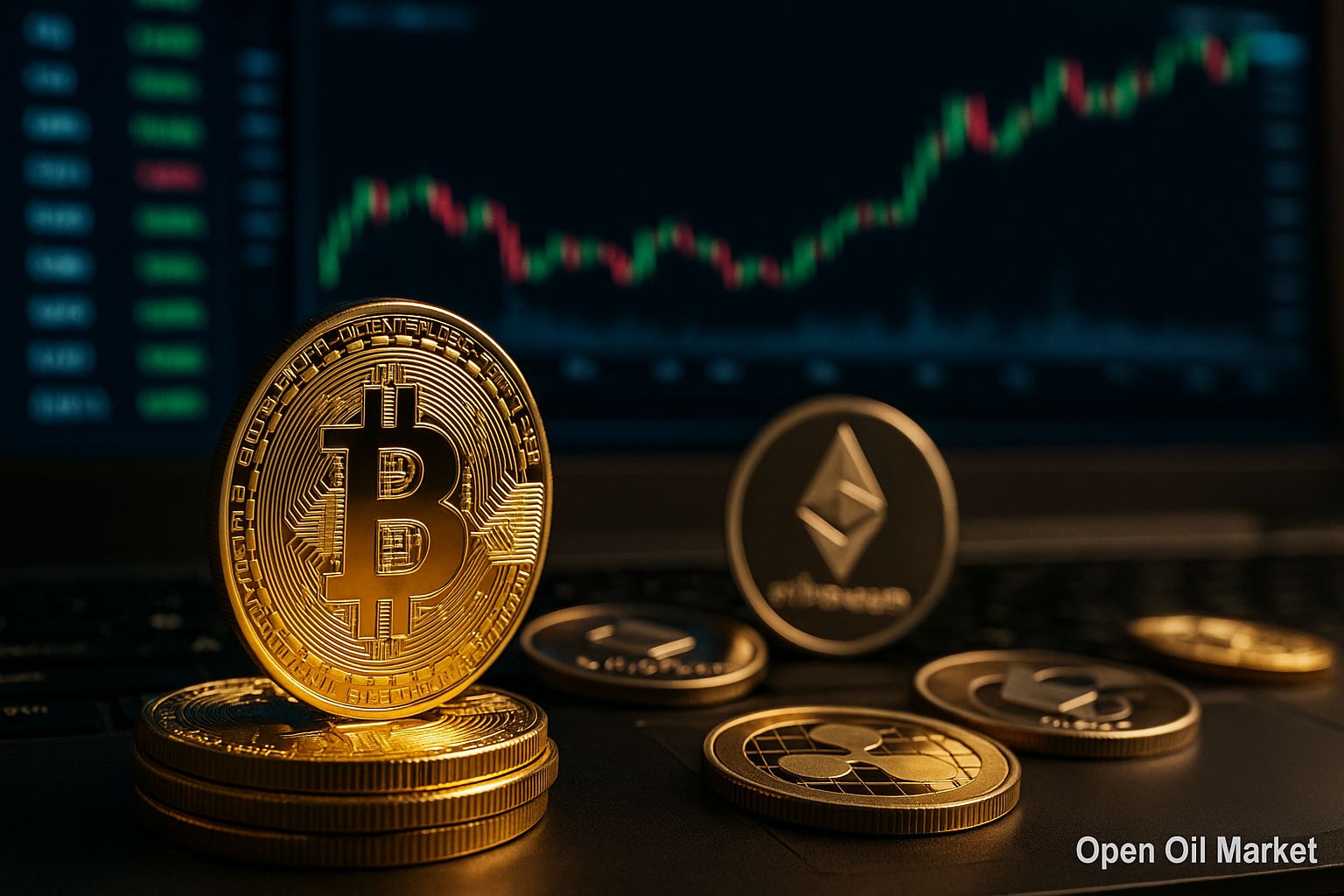
Cryptocurrency News, Monday, July 28, 2025 — Crypto Market Holds at Peak; Ethereum on Track for $4,000
As of early Monday, July 28, 2025, the cryptocurrency market maintains its position near historical peaks following an impressive rally in recent weeks and significant strides in regulation. Bitcoin is consolidating around its peak values, while leading altcoins, spearheaded by Ethereum, are showing strength amid an influx of institutional investments and growing trust in the sector. Below, we explore the key news and trends in the cryptocurrency market as of July 28, 2025, that are crucial for investors to know.
Crypto Market Holds at Historical Peaks
The global capitalization of digital assets confidently remains around record levels (approximately $3.9 trillion) after a recent surge in growth. The market is consolidating at these levels with moderate volatility. The Crypto Fear & Greed Index is in the "Greed" zone, indicating prevailing optimism among participants. Bitcoin's market share is estimated at about half of the total capitalization, reflecting both the strength of the flagship and the significant contributions of altcoins to the current rally. Investment demand remains high due to greater regulatory clarity in key markets and a continued influx of institutional capital into the industry.
Bitcoin Consolidates Near Record Highs
Bitcoin (BTC), the largest cryptocurrency, approached the $125,000 mark last week, surpassing its previous historical peak (~$123,000). Currently, BTC is trading slightly below its peak (around $118–120k), demonstrating unusually resilient dynamics for such high prices. A brief profit-taking dip below $115k quickly attracted new buyers, indicating sustained high demand. This powerful growth of Bitcoin in 2025 has been driven by two key factors: the influx of institutional investments via spot crypto ETFs and a limited supply of coins (the 2024 halving effect). Bitcoin faces new opportunities ahead, with several analysts predicting a rise to $150,000 by the end of the year (some bold estimates reaching up to $200,000), although volatility remains. Any economic or political shocks could provoke a price correction. Nonetheless, the fundamental background remains positive, and many investors adhere to a buy-the-dip strategy, anticipating further long-term growth for BTC.
Ethereum and Altcoins Continue to Climb
Ethereum (ETH), the second-largest cryptocurrency by market capitalization, continues to strengthen confidently. The ETH price is approaching the psychological mark of $4,000, which would mark the highest level in recent years. The dynamics of Ethereum are positively influenced by the success of the decentralized finance (DeFi) ecosystem and the popularity of NFT tokens, as well as ongoing technical improvements to the network (enhancements in scalability and efficiency of Ethereum). Institutional interest in ETH is also rising: record amounts are being invested in funds and ETFs based on Ethereum, indicating strong trust in the smart contract platform.
Among altcoins, XRP and BNB stand out particularly. XRP (the token of the Ripple payment network) remains near its multi-year high, exceeding $3, gaining a powerful boost following Ripple's legal victory over the SEC, which provided regulatory clarity for the token. Binance Coin (BNB), the cryptocurrency of the largest exchange Binance, trades at highs not seen in over a year (around $780) — despite past difficulties faced by Binance, the token hit a record during the exchange's ecosystem expansion. Other major altcoins also strengthen their positions. Cardano (ADA) is gradually growing as its blockchain platform develops; Solana (SOL) has recovered from the decline of 2022, once again attracting investors with its high transaction speed and network scalability. The popular "meme" coin Dogecoin (DOGE) remains on the rise, receiving an additional boost from rumors about DOGE's integration into a major payment service. Stablecoins continue to play an important role in the ecosystem as a "safe haven": the largest of them — Tether (USDT) and USD Coin (USDC) — remain firmly pegged to the dollar 1:1 and are widely used by investors to preserve capital amidst market fluctuations. Their cumulative market share has slightly decreased amid the growth of other assets, but they remain basic liquidity tools in the crypto market.
Top 10 Most Popular Cryptocurrencies
Despite the existence of thousands of digital coins, investors' attention is focused on a few of the largest assets. Below is the current list of the top 10 cryptocurrencies by market capitalization today:
- Bitcoin (BTC) — the first and largest cryptocurrency, often referred to as "digital gold." Bitcoin remains the main market benchmark and recently set a new price record, reinforcing its status as a reliable asset in the eyes of investors.
- Ethereum (ETH) — the second-largest crypto asset and leading smart contract platform. Ethereum underpins most DeFi and NFT decentralized applications and continues to strengthen its positions due to the development of its ecosystem.
- XRP (XRP) — Ripple's payment network token for fast international transfers. XRP has significantly risen in price amid positive regulatory changes and Ripple's legal victory, returning to levels not seen since 2018.
- Tether (USDT) — the largest stablecoin pegged to the US dollar at a 1:1 ratio. USDT is widely used by traders to preserve value amid market volatility and serves as one of the main liquidity tools in crypto trading.
- Binance Coin (BNB) — the native cryptocurrency of the Binance exchange and its blockchain ecosystem (BNB Chain). BNB is used for paying trading fees and participating in the exchange's DeFi projects; its price has significantly increased along with the growth of the ecosystem and user base.
- USD Coin (USDC) — a popular dollar stablecoin issued by Circle and Coinbase. USDC is known for its transparency in reserves and regulatory support, which enhances market trust in it.
- Cardano (ADA) — a cryptocurrency and blockchain platform that evolves based on a scientific approach (formal methods, Proof-of-Stake algorithm). ADA consistently ranks among the top ten, attracting infrastructure developers and long-term investors, although its price remains below historical highs.
- Dogecoin (DOGE) — a well-known "meme cryptocurrency" originally created as a joke-based project. Due to its active community and support from prominent entrepreneurs, DOGE continues to be in demand and remains one of the largest digital assets by market capitalization.
- Solana (SOL) — a high-speed blockchain for scalable decentralized applications. Solana has returned to the top 10, bolstered by technical innovations and regained investor trust after overcoming previous years' challenges.
- TRON (TRX) — a platform for smart contracts and decentralized applications, particularly popular in Asia. The TRX token remains among the leaders largely due to its active use in stablecoin transactions and a wide range of service ecosystems.
Cryptocurrency Regulation: Global Progress
The regulatory environment surrounding digital assets continues to evolve worldwide. Measures are being adopted across various jurisdictions to integrate cryptocurrencies into the legal framework:
- USA: In the United States, a historic move has been made — President Donald Trump signed the first federal law regulating stablecoins (the GENIUS Act). This act requires 100% reserve backing for issued stablecoins and regular reporting by issuers, providing legal clarity for the industry. After a series of legal defeats (including the Ripple case), the U.S. regulator (SEC) has notably softened its rhetoric, approving a number of initiatives. In July, the House of Representatives also approved a separate bill establishing rules for cryptocurrency exchanges and the digital asset market — an important step towards integrating the crypto market into the legal framework.
- European Union: The EU's comprehensive MiCA regulation has come into effect, introducing uniform standards for regulating crypto assets across the EU. The new licensing and oversight regime ensures transparency in the operations of crypto companies and investor protection, stimulating the flow of capital into the legal realm and strengthening Europe's position in the global crypto market.
- Asia: Approaches in Asian countries vary. Hong Kong is launching a licensing regime for stablecoin issuers and crypto exchanges starting August 1, offering liberal conditions for crypto business in an effort to become a regional hub. Meanwhile, Japan maintains strict restrictions on cryptocurrency operations. Regulators in other parts of Asia and the Middle East are also gradually opening up to the industry, although the emphasis is placed on risk control and investor protection.
Despite varying reform paces, the overall trend is shifting towards legalization. The crypto industry is gradually emerging from the "gray area" and gaining official recognition, which enhances trust in the market from major financial players.
Institutional and Corporate Investors in the Market
Major institutional players continue to increase their presence in the crypto industry. Banks and investment firms are launching new products based on digital assets and offering clients services for the custody and management of cryptocurrencies. In 2025, several financial giants on Wall Street filed applications to launch spot Bitcoin ETFs, while existing cryptocurrency funds are experiencing record capital inflows (including into Ethereum funds) totaling billions of dollars — a testament to the sustained interest and trust from traditional investors.
Traditional exchanges and banks are also exploring the potential uses of cryptocurrencies in transactions. For instance, Bank of America has publicly expressed interest in using stablecoins to expedite international transfers. Corporations are not standing aside either: several publicly traded companies — from IT giants to retailers — are incorporating Bitcoin into their reserves or accepting payments in cryptocurrency. These steps indicate a transformation of digital currencies from an experiment into a full-fledged financial instrument. The entry of "long money" from institutions and corporations enhances market stability, gradually reducing the influence of speculative surges on prices.
Acceptance of Cryptocurrencies: Rising Trust
The year 2025 has marked significant growth in the mass adoption of cryptocurrencies. The number of market participants — both institutional and private — has increased significantly. Large companies are increasingly holding Bitcoin in their reserves, while banks and funds are launching products like crypto ETFs and custodial services, integrating digital assets into the traditional financial system. At the consumer level, more retail businesses and online services are accepting cryptocurrency payments; transactions involving real estate purchased with BTC and ETH are being recorded.
According to analysts, the number of cryptocurrency owners worldwide has already surpassed 500 million — double the figure from two years ago. The industry, in general, is maturing, although concerns regarding security and volatility still persist. Nevertheless, digital assets are increasingly perceived as an integral part of the modern financial system, and the rising trust from a broader audience supports the long-term potential of the market.
Analysts’ Forecasts and Risks
Sentiment in the cryptocurrency market remains predominantly optimistic, but experts urge investors to take a measured approach. Bold price forecasts are being voiced: some analysts expect Bitcoin to rise to $180,000–200,000, and Ethereum to $5,000–7,000 in the foreseeable future, based on Bitcoin's limited supply, expanding use cases for blockchain, and the emergence of clear rules for the industry. However, risks remain. The cryptocurrency market is still volatile: sharp price corrections are common following surges. The regulatory environment remains unfavorable in several countries — some have strict restrictions or are discussing new bans on cryptocurrency operations. Additionally, 2025 has seen an increase in cases of hacking and fraud, underlining the necessity for heightened attention to cybersecurity. Rational asset diversification and a long-term investment horizon remain the best defenses for market participants amidst possible turbulence.
Conclusions and Prospects
Historic regulatory steps for cryptocurrencies and new price records signal the industry's transition to a more mature phase, where digital assets are becoming more deeply integrated into the global financial system. The record growth of Bitcoin and the influx of capital into the industry bolster investor confidence in the long-term prospects of the market.
The baseline scenario for the near future remains optimistic: barring any serious upheaval, Bitcoin and Ethereum are expected to hold their positions near their peaks, with investors' capital likely flowing into the most promising altcoins, accelerating their growth. The increased role of institutional players entering this market should contribute to smoother corrections. Concurrently, the rapid pace of industry development requires participants to adopt a measured approach. Regulatory reforms open new opportunities, but it is essential to comply with established rules and maintain financial discipline. In the coming months, the community's attention will be focused on the further actions of lawmakers in key markets.
With moderate caution, diversification, and a long-term focus, the crypto industry has every chance to end 2025 on a high note, laying the groundwork for further growth in 2026.




